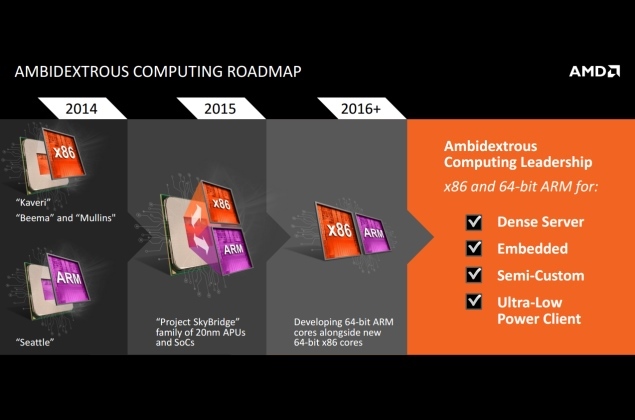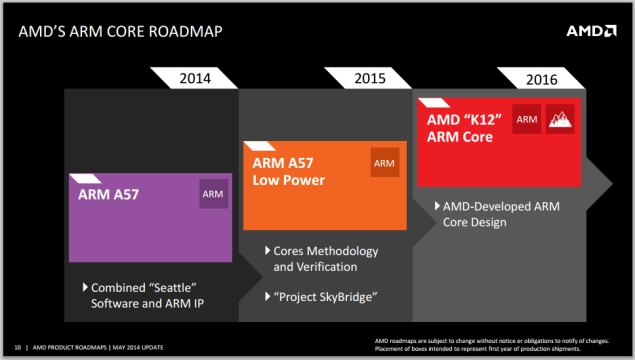- Home
- Laptops
- Laptops News
- AMD Announces 'Project SkyBridge' Family of Swappable ARM and x86 SoCs for 2015
AMD Announces 'Project SkyBridge' Family of Swappable ARM and x86 SoCs for 2015
By Jamshed Avari | Updated: 6 May 2014 17:43 IST

Click Here to Add Gadgets360 As A Trusted Source

Advertisement
Chipmaker AMD has announced a major push into ARM territory, with a product family consisting of interoperable ARM and x86 system-on-a-chip products that will debut in 2015. The effort, codenamed Project SkyBridge, will position AMD against established ARM processor manufacturers, and will give device manufacturers the advantage of being able to scale products across the Android and Windows ecosystems with minimal retooling.
Project SkyBridge will consist of SoCs based on ARM's Cortex A57 architecture as well as AMD's own next-generation Puma+ x86 architecture. The two will be pin-compatible and share the same system architecture and will both draw on AMD's Graphics Core Next integrated GPUs. Products will be aimed at consumer markets, and will give AMD its first toehold in the Android portable device ecosystem.
While end users won't be swapping between CPU architectures on a whim anytime soon, the move will allow manufacturers of consumer and embedded device manufacturers to roll out a variety of products based on a common platform, thus optimising development and production costs. For example, manufacturers could offer tablet models running Android or Windows, with the only hardware difference between them being the SoC. Everything else, including the motherboard, could be common between the two. AMD could also potentially lower its own production and fabrication costs by using the same SoC building blocks, apart from the CPU cores themselves, across product types.

AMD also revealed plans to develop its own in-house ARM core design based on the 64-bit ARMv8 ISA. While initial Project SkyBridge parts in 2015 will use ARM's existing Cortex A57 design with a few tweaks, AMD will move to its own in-house "K12" core design in 2016. K12 will sit alongside the successor to the Bulldozer X86 core design in AMD's future product lineup.
Project SkyBridge would give AMD the unique advantage of being the only company that could cater to device manufacturers' needs across the product stack.
AMD had previously announced its entry into the ARM space by acquiring a license from ARM Holdings in mid-2012. It later announced a new ARM-based server product for low-power applications, codenamed Seattle, which the company has also demonstrated publicly for the first time. Opteron A1100 server CPUs based on the Seattle architecture are expected to go on sale in late 2014. The forthcoming K12 is the result of an expanded licensing agreement between the two companies, also announced today.
Along with ARM, Qualcomm, Imagination, Mediatek, Samsung and Texas Instruments, AMD hd also launched the Heterogenous System Architecture foundation in 2012 to promote industry-wide adoption of a hardware and software ecosystem capable of using diverse architectures, across CPUs, GPUs and other specialised acceleration units, as per the demands of any workload.
Project SkyBridge will consist of SoCs based on ARM's Cortex A57 architecture as well as AMD's own next-generation Puma+ x86 architecture. The two will be pin-compatible and share the same system architecture and will both draw on AMD's Graphics Core Next integrated GPUs. Products will be aimed at consumer markets, and will give AMD its first toehold in the Android portable device ecosystem.
While end users won't be swapping between CPU architectures on a whim anytime soon, the move will allow manufacturers of consumer and embedded device manufacturers to roll out a variety of products based on a common platform, thus optimising development and production costs. For example, manufacturers could offer tablet models running Android or Windows, with the only hardware difference between them being the SoC. Everything else, including the motherboard, could be common between the two. AMD could also potentially lower its own production and fabrication costs by using the same SoC building blocks, apart from the CPU cores themselves, across product types.
AMD also revealed plans to develop its own in-house ARM core design based on the 64-bit ARMv8 ISA. While initial Project SkyBridge parts in 2015 will use ARM's existing Cortex A57 design with a few tweaks, AMD will move to its own in-house "K12" core design in 2016. K12 will sit alongside the successor to the Bulldozer X86 core design in AMD's future product lineup.
Project SkyBridge would give AMD the unique advantage of being the only company that could cater to device manufacturers' needs across the product stack.
AMD had previously announced its entry into the ARM space by acquiring a license from ARM Holdings in mid-2012. It later announced a new ARM-based server product for low-power applications, codenamed Seattle, which the company has also demonstrated publicly for the first time. Opteron A1100 server CPUs based on the Seattle architecture are expected to go on sale in late 2014. The forthcoming K12 is the result of an expanded licensing agreement between the two companies, also announced today.
Along with ARM, Qualcomm, Imagination, Mediatek, Samsung and Texas Instruments, AMD hd also launched the Heterogenous System Architecture foundation in 2012 to promote industry-wide adoption of a hardware and software ecosystem capable of using diverse architectures, across CPUs, GPUs and other specialised acceleration units, as per the demands of any workload.
Comments
Catch the latest from the Consumer Electronics Show on Gadgets 360, at our CES 2026 hub.
Related Stories
Popular on Gadgets
- Samsung Galaxy Unpacked 2025
- ChatGPT
- Redmi Note 14 Pro+
- iPhone 16
- Apple Vision Pro
- Oneplus 12
- OnePlus Nord CE 3 Lite 5G
- iPhone 13
- Xiaomi 14 Pro
- Oppo Find N3
- Tecno Spark Go (2023)
- Realme V30
- Best Phones Under 25000
- Samsung Galaxy S24 Series
- Cryptocurrency
- iQoo 12
- Samsung Galaxy S24 Ultra
- Giottus
- Samsung Galaxy Z Flip 5
- Apple 'Scary Fast'
- Housefull 5
- GoPro Hero 12 Black Review
- Invincible Season 2
- JioGlass
- HD Ready TV
- Laptop Under 50000
- Smartwatch Under 10000
- Latest Mobile Phones
- Compare Phones
Latest Gadgets
- OPPO Reno 15 Pro Max
- Honor Win RT
- Honor Win
- Xiaomi 17 Ultra Leica Edition
- Xiaomi 17 Ultra
- Huawei Nova 15
- Huawei Nova 15 Pro
- Huawei Nova 15 Ultra
- Asus ProArt P16
- MacBook Pro 14-inch (M5, 2025)
- OPPO Pad Air 5
- Huawei MatePad 11.5 (2026)
- Xiaomi Watch 5
- Huawei Watch 10th Anniversary Edition
- Acerpure Nitro Z Series 100-inch QLED TV
- Samsung 43 Inch LED Ultra HD (4K) Smart TV (UA43UE81AFULXL)
- Asus ROG Ally
- Nintendo Switch Lite
- Haier 1.6 Ton 5 Star Inverter Split AC (HSU19G-MZAID5BN-INV)
- Haier 1.6 Ton 5 Star Inverter Split AC (HSU19G-MZAIM5BN-INV)
© Copyright Red Pixels Ventures Limited 2026. All rights reserved.

















